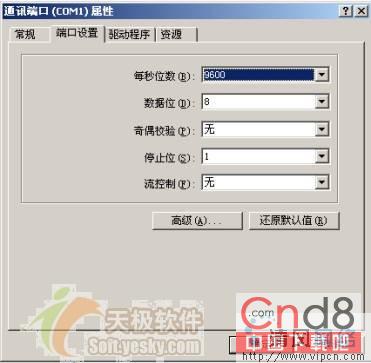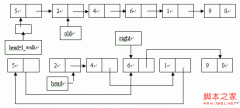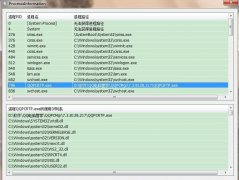深入浅出Win32多线程程序设计之综合实例[组图]
本章我们将以工业控制和嵌入式系统中运用极为广泛的串口通信为例讲述多线程的典型应用。 而网络通信也是多线程应用最广泛的领域之一,所以本章的最后一节也将对多线程网络通信
本章我们将以工业控制和嵌入式系统中运用极为广泛的串口通信为例讲述多线程的典型应用。
而网络通信也是多线程应用最广泛的领域之一,所以本章的最后一节也将对多线程网络通信进行简短的描述。
1.串口通信
在工业控制系统中,工控机(一般都基于PC Windows平台)经常需要与单片机通过串口进行通信。因此,操作和使用PC的串口成为大多数单片机、嵌入式系统领域工程师必须具备的能力。
串口的使用需要通过三个步骤来完成的:
(1) 打开通信端口;
(2) 初始化串口,设置波特率、数据位、停止位、奇偶校验等参数。为了给读者一个直观的印象,下图从Windows的"控制面板->系统->设备治理器->通信端口(COM1)"打开COM的设置窗口:

(3) 读写串口。
在WIN32平台下,对通信端口进行操作跟基本的文件操作一样。
创建/打开COM资源
下列函数假如调用成功,则返回一个标识通信端口的句柄,否则返回-1:
HADLE CreateFile(PCTSTR lpFileName, //通信端口名,如"COM1"
Word dwDesiredAccess, //对资源的访问类型
WORD dwShareMode, //指定共享模式,COM不能共享,该参数为0
PSECURITY_ATTRIBUTES lpSecurityAttributes,
//安全描述符指针,可为NULL
WORD dwCreationDisposition, //创建方式
WORD dwFlagsAndAttributes, //文件属性,可为NULL
HANDLE hTemplateFile //模板文件句柄,置为NULL
);
获得/设置COM属性
下列函数可以获得COM口的设备控制块,从而获得相关参数:
BOOL WINAPI GetCommState(
HANDLE hFile, //标识通信端口的句柄
LPDCB lpDCB //指向一个设备控制块(DCB结构)的指针
);
假如要调整通信端口的参数,则需要重新配置设备控制块,再用WIN32 API SetCommState()函数进行设置:
BOOL SetCommState(
HANDLE hFile, //标识通信端口的句柄
LPDCB lpDCB //指向一个设备控制块(DCB结构)的指针
);
DCB结构包含了串口的各项参数设置,如下:
typedef strUCt _DCB
{
// dcb
DWORD DCBlength; // sizeof(DCB)
DWORD BaudRate; // current baud rate
DWORD fBinary: 1; // binary mode, no EOF check
DWORD fParity: 1; // enable parity checking
DWORD fOutxCtsFlow: 1; // CTS output flow control
DWORD fOutxDsrFlow: 1; // DSR output flow control
DWORD fDtrControl: 2; // DTR flow control type
DWORD fDsrSensitivity: 1; // DSR sensitivity
DWORD fTXContinueOnXoff: 1; // XOFF continues Tx
DWORD fOutX: 1; // XON/XOFF out flow control
DWORD fInX: 1; // XON/XOFF in flow control
DWORD fErrorChar: 1; // enable error replacement
DWORD fNull: 1; // enable null stripping
DWORD fRtsControl: 2; // RTS flow control
DWORD fAbortOnError: 1; // abort reads/writes on error
DWORD fDummy2: 17; // reserved
WORD wReserved; // not currently used
WORD XonLim; // transmit XON threshold
WORD XoffLim; // transmit XOFF threshold
BYTE ByteSize; // number of bits/byte, 4-8
BYTE Parity; // 0-4=no,odd,even,mark,space
BYTE StopBits; // 0,1,2 = 1, 1.5, 2
char XonChar; // Tx and Rx XON character
char XoffChar; // Tx and Rx XOFF character
char ErrorChar; // error replacement character
char EofChar; // end of input character
char EvtChar; // received event character
WORD wReserved1; // reserved; do not use
} DCB;
读写串口
在读写串口之前,还要用PurgeComm()函数清空缓冲区,并用SetCommMask ()函数设置事件掩模来监视指定通信端口上的事件,其原型为:
BOOL SetCommMask(
HANDLE hFile, //标识通信端口的句柄
DWORD dwEvtMask //能够使能的通信事件
);
串口上可能发生的事件如下表所示:
值 事件描述 EV_BREAK A break was detected on input. EV_CTS The CTS (clear-to-send) signal changed state. EV_DSR The DSR(data-set-ready) signal changed state. EV_ERR A line-status error occurred. Line-status errors are CE_FRAME, CE_OVERRUN, and CE_RXPARITY. EV_RING A ring indicator was detected. EV_RLSD The RLSD (receive-line-signal-detect) signal changed state. EV_RXCHAR A character was received and placed in the input buffer. EV_RXFLAG The event character was received and placed in the input buffer. The event character is specified in the device's DCB structure, which is applied to a serial port by using the SetCommState function. EV_TXEMPTY The last character in the output buffer was sent.
在设置好事件掩模后,我们就可以利用WaitCommEvent()函数来等待串口上发生事件,其函数原型为:
BOOL WaitCommEvent(
HANDLE hFile, //标识通信端口的句柄
LPDWORD lpEvtMask, //指向存放事件标识变量的指针
LPOVERLAPPED lpOverlapped, // 指向overlapped结构
);
我们可以在发生事件后,根据相应的事件类型,进行串口的读写操作:
BOOL ReadFile(HANDLE hFile, //标识通信端口的句柄
LPVOID lpBuffer, //输入数据Buffer指针
DWORD nNumberOfBytesToRead, // 需要读取的字节数
LPDWORD lpNumberOfBytesRead, //实际读取的字节数指针
LPOVERLAPPED lpOverlapped //指向overlapped结构
);
BOOL WriteFile(HANDLE hFile, //标识通信端口的句柄
LPCVOID lpBuffer, //输出数据Buffer指针
DWORD nNumberOfBytesToWrite, //需要写的字节数
LPDWORD lpNumberOfBytesWritten, //实际写入的字节数指针
LPOVERLAPPED lpOverlapped //指向overlapped结构
); 2.工程实例
下面我们用第1节所述API实现一个多线程的串口通信程序。这个例子工程(工程名为MultiThreadCom)的界面很简单,如下图所示:

它是一个多线程的应用程序,包括两个工作者线程,分别处理串口1和串口2。为了简化问题,我们让连接两个串口的电缆只包含RX、TX两根连线(即不以硬件控制RS-232,串口上只会发生EV_TXEMPTY、EV_RXCHAR事件)。
在工程实例的BOOL CMultiThreadComApp::InitInstance()函数中,启动并设置COM1和COM2,其源代码为:
BOOL CMultiThreadComApp::InitInstance()
{
AfxEnableControlContainer();
//打开并设置COM1
hComm1=CreateFile("COM1", GENERIC_READGENERIC_WRITE, 0, NULL ,OPEN_EXISTING, 0,NULL);
if (hComm1==(HANDLE)-1)
{
AfxMessageBox("打开COM1失败");
return false;
}
else
{
DCB wdcb;
GetCommState (hComm1,&wdcb);
wdcb.BaudRate=9600;
SetCommState (hComm1,&wdcb);
PurgeComm(hComm1,PURGE_TXCLEAR);
}
//打开并设置COM2
hComm2=CreateFile("COM2", GENERIC_READGENERIC_WRITE, 0, NULL ,OPEN_EXISTING, 0,NULL);
if (hComm2==(HANDLE)-1)
{
AfxMessageBox("打开COM2失败");
return false;
}
else
{
DCB wdcb;
GetCommState (hComm2,&wdcb);
wdcb.BaudRate=9600;
SetCommState (hComm2,&wdcb);
PurgeComm(hComm2,PURGE_TXCLEAR);
}
CMultiThreadComDlg dlg;
m_pMainWnd = &dlg;
int nResponse = dlg.DoModal();
if (nResponse == IDOK)
{
// TODO: Place code here to handle when the dialog is
// dismissed with OK
}
else if (nResponse == IDCANCEL)
{
// TODO: Place code here to handle when the dialog is
// dismissed with Cancel
}
return FALSE;
}
此后我们在对话框CMultiThreadComDlg的初始化函数OnInitDialog中启动两个分别处理COM1和COM2的线程:
BOOL CMultiThreadComDlg::OnInitDialog()
{
CDialog::OnInitDialog();
// Add "About..." menu item to system menu.
// IDM_ABOUTBOX must be in the system command range.
ASSERT((IDM_ABOUTBOX & 0xFFF0) == IDM_ABOUTBOX);
ASSERT(IDM_ABOUTBOX < 0xF000);
CMenu* pSysMenu = GetSystemMenu(FALSE);
if (pSysMenu != NULL)
{
CString strAboutMenu;
strAboutMenu.LoadString(IDS_ABOUTBOX);
if (!strAboutMenu.IsEmpty())
{
pSysMenu->AppendMenu(MF_SEPARATOR);
pSysMenu->AppendMenu(MF_STRING, IDM_ABOUTBOX, strAboutMenu);
}
}
// Set the icon for this dialog. The framework does this automatically
// when the application's main window is not a dialog
SetIcon(m_hIcon, TRUE); // Set big icon
SetIcon(m_hIcon, FALSE); // Set small icon
// TODO: Add extra initialization here
//启动串口1处理线程
DWORD nThreadId1;
hCommThread1 = ::CreateThread((LPSECURITY_ATTRIBUTES)NULL, 0,
(LPTHREAD_START_ROUTINE)Com1ThreadProcess, AfxGetMainWnd()->m_hWnd, 0, &nThreadId1);
if (hCommThread1 == NULL)
{
AfxMessageBox("创建串口1处理线程失败");
return false;
}
//启动串口2处理线程
DWORD nThreadId2;
hCommThread2 = ::CreateThread((LPSECURITY_ATTRIBUTES)NULL, 0,
(LPTHREAD_START_ROUTINE)Com2ThreadProcess, AfxGetMainWnd()->m_hWnd, 0, &nThreadId2);
if (hCommThread2 == NULL)
{
AfxMessageBox("创建串口2处理线程失败");
return false;
}
return TRUE; // return TRUE unless you set the focus to a control
}
两个串口COM1和COM2对应的线程处理函数等待串口上发生事件,并根据事件类型和自身缓冲区是否有数据要发送进行相应的处理,其源代码为:
DWORD WINAPI Com1ThreadProcess(HWND hWnd//主窗口句柄)
{
DWORD wEven;
char str[10]; //读入数据
SetCommMask(hComm1, EV_RXCHAR EV_TXEMPTY);
while (TRUE)
{
WaitCommEvent(hComm1, &wEven, NULL);
if(wEven = 0)
{
CloseHandle(hCommThread1);
hCommThread1 = NULL;
ExitThread(0);
}
else
{
switch (wEven)
{
case EV_TXEMPTY:
if (wTxPos < wTxLen)
{
//在串口1写入数据
DWORD wCount; //写入的字节数
WriteFile(hComm1, com1Data.TxBuf[wTxPos], 1, &wCount, NULL);
com1Data.wTxPos++;
}
break;
case EV_RXCHAR:
if (com1Data.wRxPos < com1Data.wRxLen)
{
//读取串口数据, 处理收到的数据
DWORD wCount; //读取的字节数
ReadFile(hComm1, com1Data.RxBuf[wRxPos], 1, &wCount, NULL);
com1Data.wRxPos++;
if(com1Data.wRxPos== com1Data.wRxLen);
::PostMessage(hWnd, COM_SENDCHAR, 0, 1);
}
break;
}
}
}
}
return TRUE;
}
DWORD WINAPI Com2ThreadProcess(HWND hWnd //主窗口句柄)
{
DWORD wEven;
char str[10]; //读入数据
SetCommMask(hComm2, EV_RXCHAR EV_TXEMPTY);
while (TRUE)
{
WaitCommEvent(hComm2, &wEven, NULL);
if (wEven = 0)
{
CloseHandle(hCommThread2);
hCommThread2 = NULL;
ExitThread(0);
}
else
{
switch (wEven)
{
case EV_TXEMPTY:
if (wTxPos < wTxLen)
{
//在串口2写入数据
DWORD wCount; //写入的字节数
WriteFile(hComm2, com2Data.TxBuf[wTxPos], 1, &wCount, NULL);
com2Data.wTxPos++;
}
break;
case EV_RXCHAR:
if (com2Data.wRxPos < com2Data.wRxLen)
{
//读取串口数据, 处理收到的数据
DWORD wCount; //读取的字节数
ReadFile(hComm2, com2Data.RxBuf[wRxPos], 1, &wCount, NULL);
com2Data.wRxPos++;
if(com2Data.wRxPos== com2Data.wRxLen);
::PostMessage(hWnd, COM_SENDCHAR, 0, 1);
}
break;
}
}
}
return TRUE;
}
线程控制函数中所操作的com1Data和com2Data是与串口对应的数据结构struct tagSerialPort的实例,这个数据结构是:
typedef struct tagSerialPort
{
BYTE RxBuf[SPRX_BUFLEN];//接收Buffer
WORD wRxPos; //当前接收字节位置
WORD wRxLen; //要接收的字节数
BYTE TxBuf[SPTX_BUFLEN];//发送Buffer
WORD wTxPos; //当前发送字节位置
WORD wTxLen; //要发送的字节数
}SerialPort, * LPSerialPort; 3.多线程串口类
使用多线程串口通信更方便的途径是编写一个多线程的串口类,例如Remon Spekreijse编写了一个CSerialPort串口类。仔细分析这个类的源代码,将十分有助于我们对先前所学多线程及同步知识的理解。
3.1类的定义
#ifndef __SERIALPORT_H__
#define __SERIALPORT_H__
#define WM_COMM_BREAK_DETECTED WM_USER+1 // A break was detected on input.
#define WM_COMM_CTS_DETECTED WM_USER+2 // The CTS (clear-to-send) signal changed state.
#define WM_COMM_DSR_DETECTED WM_USER+3 // The DSR (data-set-ready) signal changed state.
#define WM_COMM_ERR_DETECTED WM_USER+4 // A line-status error occurred. Line-status errors are CE_FRAME, CE_OVERRUN, and CE_RXPARITY.
#define WM_COMM_RING_DETECTED WM_USER+5 // A ring indicator was detected.
#define WM_COMM_RLSD_DETECTED WM_USER+6 // The RLSD (receive-line-signal-detect) signal changed state.
#define WM_COMM_RXCHAR WM_USER+7 // A character was received and placed in the input buffer.
#define WM_COMM_RXFLAG_DETECTED WM_USER+8 // The event character was received and placed in the input buffer.
#define WM_COMM_TXEMPTY_DETECTED WM_USER+9 // The last character in the output buffer was sent.
class CSerialPort
{
public:
// contruction and destruction
CSerialPort();
virtual ~CSerialPort();
// port initialisation
BOOL InitPort(CWnd* pPortOwner, UINT portnr = 1, UINT baud = 19200, char parity = 'N', UINT databits = 8, UINT stopsbits = 1, DWORD dwCommEvents = EV_RXCHAR EV_CTS, UINT nBufferSize = 512);
// start/stop comm watching
BOOL StartMonitoring();
BOOL RestartMonitoring();
BOOL StopMonitoring();
DWORD GetWriteBufferSize();
DWORD GetCommEvents();
DCB GetDCB();
void WriteToPort(char* string);
protected:
// protected memberfunctions
void ProcessErrorMessage(char* ErrorText);
static UINT CommThread(LPVOID pParam);
static void ReceiveChar(CSerialPort* port, COMSTAT comstat);
static void WriteChar(CSerialPort* port);
// thread
CWinThread* m_Thread;
// synchronisation objects
CRITICAL_SECTION m_csCommunicationSync;
BOOL m_BThreadAlive;
// handles
HANDLE m_hShutdownEvent;
HANDLE m_hComm;
HANDLE m_hWriteEvent;
// Event array.
// One element is used for each event. There are two event handles for each port.
// A Write event and a receive character event which is located in the overlapped structure (m_ov.hEvent).
// There is a general shutdown when the port is closed.
HANDLE m_hEventArray[3];
// structures
OVERLAPPED m_ov;
COMMTIMEOUTS m_CommTimeouts;
DCB m_dcb;
// owner window
CWnd* m_pOwner;
// misc
UINT m_nPortNr;
char* m_szWriteBuffer;
DWORD m_dwCommEvents;
DWORD m_nWriteBufferSize;
};
#endif __SERIALPORT_H__
3.2类的实现
3.2.1构造函数与析构函数
进行相关变量的赋初值及内存恢复:
CSerialPort::CSerialPort()
{
m_hComm = NULL;
// initialize overlapped structure members to zero
m_ov.Offset = 0;
m_ov.OffsetHigh = 0;
// create events
m_ov.hEvent = NULL;
m_hWriteEvent = NULL;
m_hShutdownEvent = NULL;
m_szWriteBuffer = NULL;
m_bThreadAlive = FALSE;
}
//
// Delete dynamic memory
//
CSerialPort::~CSerialPort()
{
do
{
SetEvent(m_hShutdownEvent);
}
while (m_bThreadAlive);
TRACE("Thread ended ");
delete []m_szWriteBuffer;
}
3.2.2核心函数:初始化串口
在初始化串口函数中,将打开串口,设置相关参数,并创建串口相关的用户控制事件,初始化临界区(Critical Section),以成队的EnterCriticalSection()、LeaveCriticalSection()函数进行资源的排它性访问:
BOOL CSerialPort::InitPort(CWnd *pPortOwner,
// the owner (CWnd) of the port (receives message)
UINT portnr, // portnumber (1..4)
UINT baud, // baudrate
char parity, // parity
UINT databits, // databits
UINT stopbits, // stopbits
DWORD dwCommEvents, // EV_RXCHAR, EV_CTS etc
UINT writebuffersize) // size to the writebuffer
{
assert(portnr > 0 && portnr < 5);
assert(pPortOwner != NULL);
// if the thread is alive: Kill
if (m_bThreadAlive)
{
do
{
SetEvent(m_hShutdownEvent);
}
while (m_bThreadAlive);
TRACE("Thread ended ");
}
// create events
if (m_ov.hEvent != NULL)
ResetEvent(m_ov.hEvent);
m_ov.hEvent = CreateEvent(NULL, TRUE, FALSE, NULL);
if (m_hWriteEvent != NULL)
ResetEvent(m_hWriteEvent);
m_hWriteEvent = CreateEvent(NULL, TRUE, FALSE, NULL);
if (m_hShutdownEvent != NULL)
ResetEvent(m_hShutdownEvent);
m_hShutdownEvent = CreateEvent(NULL, TRUE, FALSE, NULL);
// initialize the event objects
m_hEventArray[0] = m_hShutdownEvent; // highest priority
m_hEventArray[1] = m_ov.hEvent;
m_hEventArray[2] = m_hWriteEvent;
// initialize critical section
InitializeCriticalSection(&m_csCommunicationSync);
// set buffersize for writing and save the owner
m_pOwner = pPortOwner;
if (m_szWriteBuffer != NULL)
delete []m_szWriteBuffer;
m_szWriteBuffer = new char[writebuffersize];
m_nPortNr = portnr;
m_nWriteBufferSize = writebuffersize;
m_dwCommEvents = dwCommEvents;
BOOL bResult = FALSE;
char *szPort = new char[50];
char *szBaud = new char[50];
// now it critical!
EnterCriticalSection(&m_csCommunicationSync);
// if the port is already opened: close it
if (m_hComm != NULL)
{
CloseHandle(m_hComm);
m_hComm = NULL;
}
// prepare port strings
sprintf(szPort, "COM%d", portnr);
sprintf(szBaud, "baud=%d parity=%c data=%d stop=%d", baud, parity, databits,stopbits);
// get a handle to the port
m_hComm = CreateFile(szPort, // communication port string (COMX)
GENERIC_READ GENERIC_WRITE, // read/write types
0, // comm devices must be opened with exclusive access
NULL, // no security attributes
OPEN_EXISTING, // comm devices must use OPEN_EXISTING
FILE_FLAG_OVERLAPPED, // Async I/O
0); // template must be 0 for comm devices
if (m_hComm == INVALID_HANDLE_VALUE)
{
// port not found
delete []szPort;
delete []szBaud;
return FALSE;
}
// set the timeout values
m_CommTimeouts.ReadIntervalTimeout = 1000;
m_CommTimeouts.ReadTotalTimeoutMultiplier = 1000;
m_CommTimeouts.ReadTotalTimeoutConstant = 1000;
m_CommTimeouts.WriteTotalTimeoutMultiplier = 1000;
m_CommTimeouts.WriteTotalTimeoutConstant = 1000;
// configure
if (SetCommTimeouts(m_hComm, &m_CommTimeouts))
{
if (SetCommMask(m_hComm, dwCommEvents))
{
if (GetCommState(m_hComm, &m_dcb))
{
m_dcb.fRtsControl = RTS_CONTROL_ENABLE; // set RTS bit high!
if (BuildCommDCB(szBaud, &m_dcb))
{
if (SetCommState(m_hComm, &m_dcb))
;
// normal operation... continue
else
ProcessErrorMessage("SetCommState()");
}
else
ProcessErrorMessage("BuildCommDCB()");
}
else
ProcessErrorMessage("GetCommState()");
}
else
ProcessErrorMessage("SetCommMask()");
}
else
ProcessErrorMessage("SetCommTimeouts()");
delete []szPort;
delete []szBaud;
// flush the port
PurgeComm(m_hComm, PURGE_RXCLEAR PURGE_TXCLEAR PURGE_RXABORT PURGE_TXABORT);
// release critical section
LeaveCriticalSection(&m_csCommunicationSync);
TRACE("Initialisation for communicationport %d completed. Use Startmonitor to communicate. ", portnr);
return TRUE;
}
3.3.3核心函数:串口线程控制函数
串口线程处理函数是整个类中最核心的部分,它主要完成两类工作:
(1)利用WaitCommEvent函数对串口上发生的事件进行获取并根据事件的不同类型进行相应的处理;
(2)利用WaitForMultipleObjects函数对串口相关的用户控制事件进行等待并做相应处理。
UINT CSerialPort::CommThread(LPVOID pParam)
{
// Cast the void pointer passed to the thread back to
// a pointer of CSerialPort class
CSerialPort *port = (CSerialPort*)pParam;
// Set the status variable in the dialog class to
// TRUE to indicate the thread is running.
port->m_bThreadAlive = TRUE;
// Misc. variables
DWORD BytesTransfered = 0;
DWORD Event = 0;
DWORD CommEvent = 0;
DWORD dwError = 0;
COMSTAT comstat;
BOOL bResult = TRUE;
// Clear comm buffers at startup
if (port->m_hComm)
// check if the port is opened
PurgeComm(port->m_hComm, PURGE_RXCLEAR PURGE_TXCLEAR PURGE_RXABORT PURGE_TXABORT);
// begin forever loop. This loop will run as long as the thread is alive.
for (;;)
{
// Make a call to WaitCommEvent(). This call will return immediatly
// because our port was created as an async port (FILE_FLAG_OVERLAPPED
// and an m_OverlappedStructerlapped structure specified). This call will cause the
// m_OverlappedStructerlapped element m_OverlappedStruct.hEvent, which is part of the m_hEventArray to
// be placed in a non-signeled state if there are no bytes available to be read,
// or to a signeled state if there are bytes available. If this event handle
// is set to the non-signeled state, it will be set to signeled when a
// character arrives at the port.
// we do this for each port!
bResult = WaitCommEvent(port->m_hComm, &Event, &port->m_ov);
if (!bResult)
{
// If WaitCommEvent() returns FALSE, process the last error to determin
// the reason..
switch (dwError = GetLastError())
{
case ERROR_IO_PENDING:
{
// This is a normal return value if there are no bytes
// to read at the port.
// Do nothing and continue
break;
}
case 87:
{
// Under Windows NT, this value is returned for some reason.
// I have not investigated why, but it is also a valid reply
// Also do nothing and continue.
break;
}
default:
{
// All other error codes indicate a serious error has
// occured. Process this error.
port->ProcessErrorMessage("WaitCommEvent()");
break;
}
}
}
else
{
// If WaitCommEvent() returns TRUE, check to be sure there are
// actually bytes in the buffer to read.
//
// If you are reading more than one byte at a time from the buffer
// (which this program does not do) you will have the situation occur
// where the first byte to arrive will cause the WaitForMultipleObjects()
// function to stop waiting. The WaitForMultipleObjects() function
// resets the event handle in m_OverlappedStruct.hEvent to the non-signelead state
// as it returns.
//
// If in the time between the reset of this event and the call to
// ReadFile() more bytes arrive, the m_OverlappedStruct.hEvent handle will be set again
// to the signeled state. When the call to ReadFile() occurs, it will
// read all of the bytes from the buffer, and the program will
// loop back around to WaitCommEvent().
//
// At this point you will be in the situation where m_OverlappedStruct.hEvent is set,
// but there are no bytes available to read. If you proceed and call
// ReadFile(), it will return immediatly due to the async port setup, but
// GetOverlappedResults() will not return until the next character arrives.
//
// It is not desirable for the GetOverlappedResults() function to be in
// this state. The thread shutdown event (event 0) and the WriteFile()
// event (Event2) will not work if the thread is blocked by GetOverlappedResults().
//
// The solution to this is to check the buffer with a call to ClearCommError().
// This call will reset the event handle, and if there are no bytes to read
// we can loop back through WaitCommEvent() again, then proceed.
// If there are really bytes to read, do nothing and proceed.
bResult = ClearCommError(port->m_hComm, &dwError, &comstat);
if (comstat.cbInQue == 0)
continue;
} // end if bResult
// Main wait function. This function will normally block the thread
// until one of nine events occur that require action.
Event = WaitForMultipleObjects(3, port->m_hEventArray, FALSE, INFINITE);
switch (Event)
{
case 0:
{
// Shutdown event. This is event zero so it will be
// the higest priority and be serviced first.
port->m_bThreadAlive = FALSE;
// Kill this thread. break is not needed, but makes me feel better.
AfxEndThread(100);
break;
}
case 1:
// read event
{
GetCommMask(port->m_hComm, &CommEvent);
if (CommEvent &EV_CTS)
::SendMessage(port->m_pOwner->m_hWnd, WM_COMM_CTS_DETECTED, (WPARAM)0, (LPARAM)port->m_nPortNr);
if (CommEvent &EV_RXFLAG)
::SendMessage(port->m_pOwner->m_hWnd, WM_COMM_RXFLAG_DETECTED,(WPARAM)0, (LPARAM)port->m_nPortNr);
if (CommEvent &EV_BREAK)
::SendMessage(port->m_pOwner->m_hWnd, WM_COMM_BREAK_DETECTED,(WPARAM)0, (LPARAM)port->m_nPortNr);
if (CommEvent &EV_ERR)
::SendMessage(port->m_pOwner->m_hWnd, WM_COMM_ERR_DETECTED, (WPARAM)0, (LPARAM)port->m_nPortNr);
if (CommEvent &EV_RING)
::SendMessage(port->m_pOwner->m_hWnd, WM_COMM_RING_DETECTED,(WPARAM)0, (LPARAM)port->m_nPortNr);
if (CommEvent &EV_RXCHAR)
// Receive character event from port.
ReceiveChar(port, comstat);
break;
}
case 2:
// write event
{
// Write character event from port
WriteChar(port);
break;
}
} // end switch
} // close forever loop
return 0;
}
下列三个函数用于对串口线程进行启动、挂起和恢复:
//
// start comm watching
//
BOOL CSerialPort::StartMonitoring()
{
if (!(m_Thread = AfxBeginThread(CommThread, this)))
return FALSE;
TRACE("Thread started ");
return TRUE;
}
//
// Restart the comm thread
//
BOOL CSerialPort::RestartMonitoring()
{
TRACE("Thread resumed ");
m_Thread->ResumeThread();
return TRUE;
}
//
// Suspend the comm thread
//
BOOL CSerialPort::StopMonitoring()
{
TRACE("Thread suspended ");
m_Thread->SuspendThread();
return TRUE;
}
3.3.4读写串口
下面一组函数是用户对串口进行读写操作的接口:
//
// Write a character.
//
void CSerialPort::WriteChar(CSerialPort *port)
{
BOOL bWrite = TRUE;
BOOL bResult = TRUE;
DWORD BytesSent = 0;
ResetEvent(port->m_hWriteEvent);
// Gain ownership of the critical section
EnterCriticalSection(&port->m_csCommunicationSync);
if (bWrite)
{
// Initailize variables
port->m_ov.Offset = 0;
port->m_ov.OffsetHigh = 0;
// Clear buffer
PurgeComm(port->m_hComm, PURGE_RXCLEAR PURGE_TXCLEAR PURGE_RXABORT PURGE_TXABORT);
bResult = WriteFile(port->m_hComm, // Handle to COMM Port
port->m_szWriteBuffer, // Pointer to message buffer in calling finction
strlen((char*)port->m_szWriteBuffer), // Length of message to send
&BytesSent, // Where to store the number of bytes sent
&port->m_ov); // Overlapped structure
// deal with any error codes
if (!bResult)
{
DWORD dwError = GetLastError();
switch (dwError)
{
case ERROR_IO_PENDING:
{
// continue to GetOverlappedResults()
BytesSent = 0;
bWrite = FALSE;
break;
}
default:
{
// all other error codes
port->ProcessErrorMessage("WriteFile()");
}
}
}
else
{
LeaveCriticalSection(&port->m_csCommunicationSync);
}
} // end if(bWrite)
if (!bWrite)
{
bWrite = TRUE;
bResult = GetOverlappedResult(port->m_hComm, // Handle to COMM port
&port->m_ov, // Overlapped structure
&BytesSent, // Stores number of bytes sent
TRUE); // Wait flag
LeaveCriticalSection(&port->m_csCommunicationSync);
// deal with the error code
if (!bResult)
{
port->ProcessErrorMessage("GetOverlappedResults() in WriteFile()");
}
} // end if (!bWrite)
// Verify that the data size send equals what we tried to send
if (BytesSent != strlen((char*)port->m_szWriteBuffer))
{
TRACE("WARNING: WriteFile() error.. Bytes Sent: %d; Message Length: %d ",
BytesSent, strlen((char*)port->m_szWriteBuffer));
}
}
//
// Character received. Inform the owner
//
void CSerialPort::ReceiveChar(CSerialPort *port, COMSTAT comstat)
{
BOOL bRead = TRUE;
BOOL bResult = TRUE;
DWORD dwError = 0;
DWORD BytesRead = 0;
unsigned char RXBuff;
for (;;)
{
// Gain ownership of the comm port critical section.
// This process guarantees no other part of this program
// is using the port object.
EnterCriticalSection(&port->m_csCommunicationSync);
// ClearCommError() will update the COMSTAT structure and
// clear any other errors.
bResult = ClearCommError(port->m_hComm, &dwError, &comstat);
LeaveCriticalSection(&port->m_csCommunicationSync);
// start forever loop. I use this type of loop because I
// do not know at runtime how many loops this will have to
// run. My solution is to start a forever loop and to
// break out of it when I have processed all of the
// data available. Be careful with this approach and
// be sure your loop will exit.
// My reasons for this are not as clear in this sample
// as it is in my production code, but I have found this
// solutiion to be the most efficient way to do this.
if (comstat.cbInQue == 0)
{
// break out when all bytes have been read
break;
}
EnterCriticalSection(&port->m_csCommunicationSync);
if (bRead)
{
bResult = ReadFile(port->m_hComm, // Handle to COMM port
&RXBuff, // RX Buffer Pointer
1, // Read one byte
&BytesRead, // Stores number of bytes read
&port->m_ov); // pointer to the m_ov structure
// deal with the error code
if (!bResult)
{
switch (dwError = GetLastError())
{
case ERROR_IO_PENDING:
{
// asynchronous i/o is still in progress
// Proceed on to GetOverlappedResults();
bRead = FALSE;
break;
}
default:
{
// Another error has occured. Process this error.
port->ProcessErrorMessage("ReadFile()");
break;
}
}
}
else
{
// ReadFile() returned complete. It is not necessary to call GetOverlappedResults()
bRead = TRUE;
}
} // close if (bRead)
if (!bRead)
{
bRead = TRUE;
bResult = GetOverlappedResult(port->m_hComm, // Handle to COMM port
&port->m_ov, // Overlapped structure
&BytesRead, // Stores number of bytes read
TRUE); // Wait flag
// deal with the error code
if (!bResult)
{
port->ProcessErrorMessage("GetOverlappedResults() in ReadFile()");
}
} // close if (!bRead)
LeaveCriticalSection(&port->m_csCommunicationSync);
// notify parent that a byte was received
::SendMessage((port->m_pOwner)->m_hWnd, WM_COMM_RXCHAR, (WPARAM)RXBuff,(LPARAM)port->m_nPortNr);
} // end forever loop
}
//
// Write a string to the port
//
void CSerialPort::WriteToPort(char *string)
{
assert(m_hComm != 0);
memset(m_szWriteBuffer, 0, sizeof(m_szWriteBuffer));
strcpy(m_szWriteBuffer, string);
// set event for write
SetEvent(m_hWriteEvent);
}
//
// Return the output buffer size
//
DWORD CSerialPort::GetWriteBufferSize()
{
return m_nWriteBufferSize;
}
3.3.5控制接口
应用程序员使用下列一组public函数可以获取串口的DCB及串口上发生的事件:
//
// Return the device control block
//
DCB CSerialPort::GetDCB()
{
return m_dcb;
}
//
// Return the communication event masks
//
DWORD CSerialPort::GetCommEvents()
{
return m_dwCommEvents;
}
3.3.6错误处理
//
// If there is a error, give the right message
//
void CSerialPort::ProcessErrorMessage(char *ErrorText)
{
char *Temp = new char[200];
LPVOID lpMsgBuf;
FormatMessage(FORMAT_MESSAGE_ALLOCATE_BUFFER FORMAT_MESSAGE_FROM_SYSTEM,
NULL, GetLastError(), MAKELANGID(LANG_NEUTRAL, SUBLANG_DEFAULT),
// Default language
(LPTSTR) &lpMsgBuf, 0, NULL);
sprintf(Temp,
"WARNING: %s Failed with the following error: %s Port: %d ", (char*)
ErrorText, lpMsgBuf, m_nPortNr);
MessageBox(NULL, Temp, "Application Error", MB_ICONSTOP);
LocalFree(lpMsgBuf);
delete []Temp;
}
仔细分析Remon Spekreijse的CSerialPort类对我们理解多线程及其同步机制是大有益处的,从http://codeguru.earthweb.com/network/serialport.sHtml我们可以获取CSerialPort类的介绍与工程实例。另外,电子工业出版社《Visual C++/Turbo C串口通信编程实践》一书的作者龚建伟也编写了一个使用CSerialPort类的例子,可以从http://www.gjwtech.com/scomm/sc2serialportclass.htm获得详情。
4.多线程网络通信
在网络通信中使用多线程主要有两种途径,即主监控线程和线程池。
4.1主监控线程
这种方式指的是程序中使用一个主线程监控某特定端口,一旦在这个端口上发生连接请求,则主监控线程动态使用CreateThread派生出新的子线程处理该请求。主线程在派生子线程后不再对子线程加以控制和调度,而由子线程独自和客户方发生连接并处理异常。
使用这种方法的优点是:
(1)可以较快地实现原型设计,尤其在用户数目较少、连接保持时间较长时有表现较好;
(2)主线程不与子线程发生通信,在一定程度上减少了系统资源的消耗。
其缺点是:
(1)生成和终止子线程的开销比较大;
(2)对远端用户的控制较弱。
这种多线程方式总的特点是"动态生成,静态调度"。
4.2线程池
这种方式指的是主线程在初始化时静态地生成一定数量的悬挂子线程,放置于线程池中。随后,主线程将对这些悬挂子线程进行动态调度。一旦客户发出连接请求,主线程将从线程池中查找一个悬挂的子线程:
(1)假如找到,主线程将该连接分配给这个被发现的子线程。子线程从主线程处接管该连接,并与用户通信。当连接结束时,该子线程将自动悬挂,并进人线程池等待再次被调度;
(2)假如当前已没有可用的子线程,主线程将通告发起连接的客户。
使用这种方法进行设计的优点是:
(1)主线程可以更好地对派生的子线程进行控制和调度;
(2)对远程用户的监控和治理能力较强。
虽然主线程对子线程的调度要消耗一定的资源,但是与主监控线程方式中派生和终止线程所要耗费的资源相比,要少很多。因此,使用该种方法设计和实现的系统在客户端连接和终止变更频繁时有上佳表现。
这种多线程方式总的特点是"静态生成,动态调度"。
精彩图集
精彩文章





